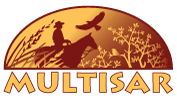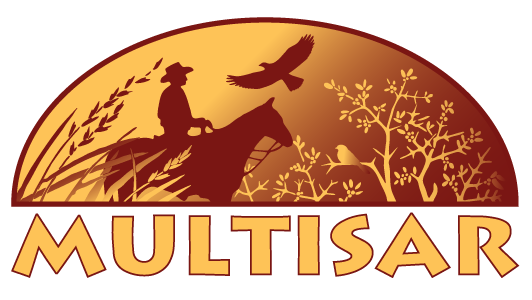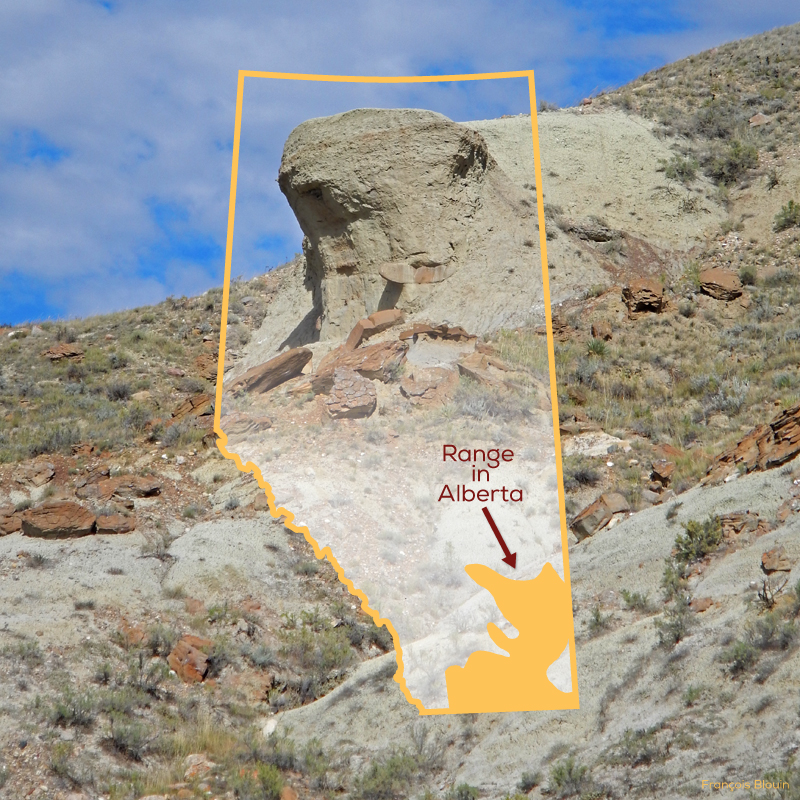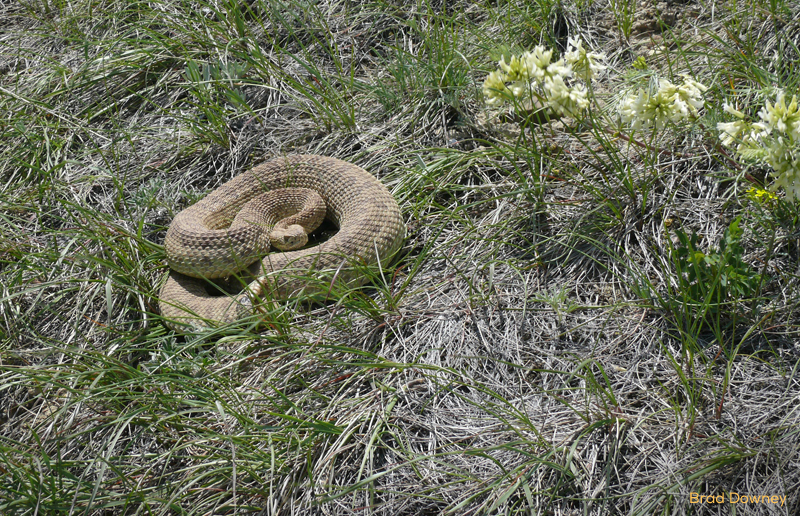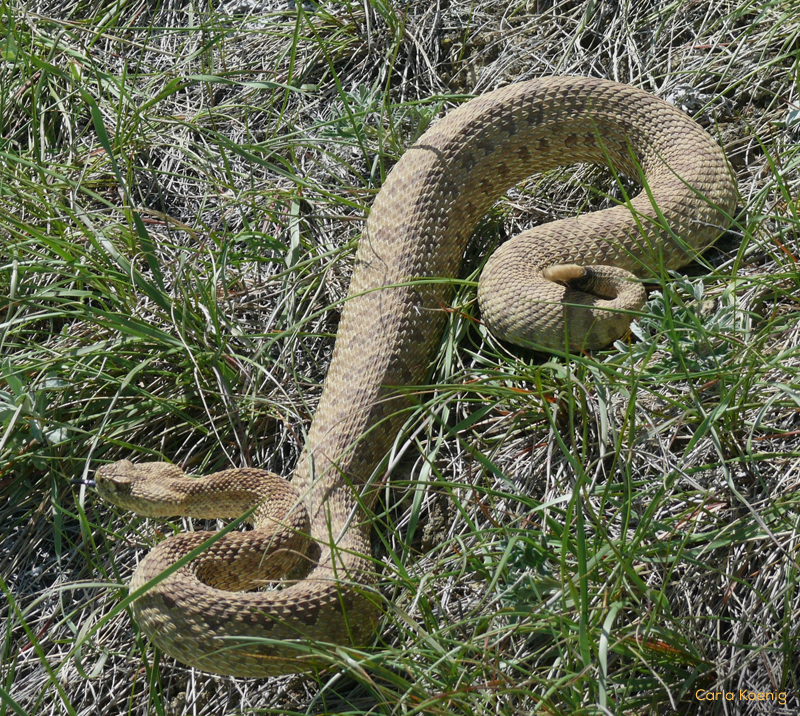Prairie Rattlesnake
Crotalus viridis
Habitat:
Foraging habitat includes native grasslands, badlands, sage flats and occasionally cropland and tame pasture. Hibernation sites and birthing sites are usually rocky or sandy and associated with river valleys or coulees.
Going Underground
To survive Alberta’s winters, Prairie Rattlesnakes hibernate in communal dens where mammal burrows, cracks and crevices extend below the frost line. They often share these dens, called “hibernacula” (singular “hibernaculum”), with Wandering Garter Snakes, Plains Garter Snakes and Bull Snakes.
Natural Nurseries
Prairie Rattlesnakes give birth to 4-13 live young in the early Fall. Pregnant females gather at warm, rocky sites, called “rookeries”, usually within 1 km of their hibernaculum and close to mammal burrows. The burrows provide shade and a place to escape from predators. Female Prairie Rattlesnakes become reproductive at five to seven years old and they only produce young every two to three years.
Predator and Prey
Prairie Rattlesnakes seek their prey using eyesight, smell and heat-sensing pits on their upper jaw. They prey on small burrowing mammals such as voles and mice, as well as some Richardson’s Ground Squirrels, pocket gophers and amphibians. In turn, they have to watch out for their predators, such as badgers, coyotes, hawks and eagles.
Why Did the Rattlesnake Cross the Road?
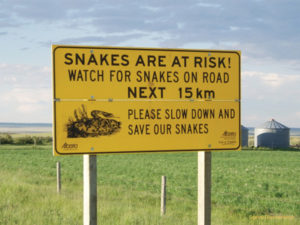
Snakes can move up to 25km away from their hibernacula in search of food. Unfortunately their movements often take them across roads where they are at risk of being hit by vehicles.
Male and non-pregnant female rattlesnakes travel up to 25 km from their hibernaculum, in search of food. They usually follow the same route back to their hibernaculum in the fall. Unfortunately some rattlesnakes are killed when their migration routes take them across roads.
Population
A comprehensive census of Alberta’s rattlesnake population has not been conducted. However, using the number of known hibernacula, a crude estimate suggests that there are between 12,078 and 15,972 adult Prairie Rattlesnakes in Alberta.
Past population information is lacking, but it appears that there has been a significant long-term population decline since the late 1800s, primarily due to persecution and habitat loss.
Current Threats
- Road mortality is one of the biggest influences on Alberta’s Prairie Rattlesnake population. This is likely to increase in the future, as several major highway developments are proposed in parts of Alberta where there are rattlesnake populations.
- Urban development is a significant threat to Prairie Rattlesnake populations in Medicine Hat and Lethbridge.
- Oil and gas development and the associated increase in roads, traffic and human disturbance.
- Where snakes use cultivated land, there can be mortality due to agricultural equipment.
- While intentional killing or capturing of rattlesnakes is illegal in Alberta, it still occurs to some degree.
Species@Risk Quiz
Test your knowledge about Alberta’s grassland species at risk
Prairie Rattlesnake
Question 1 |
The place where Prairie Rattlesnakes spend the winter is called:
A Rookery
| |
A Hibernaculum | |
An Eyrie |
Question 2 |
Once Prairie Rattlesnake populations are low, they take a long time to recover because:
There is a low survival rate of young snakes.
| |
Females don’t reproduce until they are 5-7 years old. | |
Females only produce young every 2-3 years. | |
All of the above |
Question 3 |
Prairie Rattlesnakes often share their winter dens with:
Richardson’s Ground Squirrels
| |
Other species of snakes | |
Badgers and coyotes |
Question 4 |
The number of segments on a Prairie Rattlesnake’s tail indicates:
How cold the upcoming winter will be
| |
The age of the rattlesnake | |
The number of times it has shed its skin |
Public
- When driving in areas where there are Prairie Rattlesnakes, pay close attention and watch for snakes on the road. Many places where snakes cross roads have signs that alert you to the possibility.
- Visit Writing-on-Stone Provincial Park or Dinosaur Provincial Park to find out more about Prairie Rattlesnakes and explore their habitats (carefully!).
- Educate yourself about how to behave and dress when hiking in rattlesnake country so as to avoid encounters.
- Support native grassland habitat by choosing grass-fed meat in the grocery store.
- Voice your support for native grassland conservation with your political leaders.
- Educate yourselves and your family about Prairie Rattlesnakes and their role in the grassland ecosystem.
Landowners
- Protect known hibernacula and rookeries from all types of disturbance and report these sites to MULTISAR.
- A 500 m year-round setback distance from hibernacula is recommended for all developments.
- Avoid grazing near hibernacula in the spring and fall.
- Tolerate some ground squirrels, as they are a food source for Prairie Rattlesnakes and their burrows are used for refuge.
- Avoid using poisons to kill rodents as this can unintentionally kill rattlesnakes.
- Steer road construction and industrial activity away from slopes, coulees and river valleys.
- When driving in areas where there are Prairie Rattlesnakes, pay close attention and watch for snakes on the road.
- Talk to your children and neighbours about the privilege of Prairie Rattlesnakes on your land.
What MULTISAR Does
- Conducts surveys for snake hibernacula as part of Habitat Conservation Strategies and Species at Risk Conservation Plans.
- Developed a habitat model to identify suitable rattlesnake habitat in the Milk River watershed.
- Provides information about Prairie Rattlesnakes and their habitat and recommendations for management practices compatible with their needs and the needs of cattle producers.
